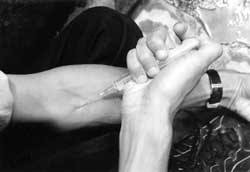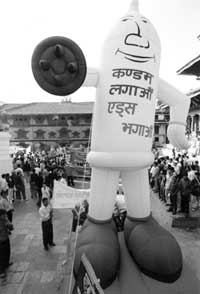 For those still sceptical that AIDS is a major crisis for Nepal, consider the following facts:
For those still sceptical that AIDS is a major crisis for Nepal, consider the following facts: . There are nearly 40,000 Nepalis living with HIV or AIDS, six times the total number of hospital beds in the country
. 3,000 Nepalis will die of AIDS this year
. 14 Nepalis are infected with HIV every day, at this rate the number of infected people will grow to 200,000 in the next 8 years
. AIDS will soon be the leading cause of death in the 15-49 age group.
There's more:
. There are 6,000 injecting drug users in Kathmandu Valley alone, this number is expected to double in the next three years
. More than half the drug users are HIV-positive
. Nearly all injecting drug users are sexually active, and almost half are married
. Three-quarters of all injecting drug users have multiple partners, and 64 percent of them do not use condoms
. One in every six sex workers in Kathmandu is positive
. Ten percent of male migrant workers returning to Doti from Bombay are HIV-positive
Are you thinking AIDS is a problem of Nepali sex workers in India and injecting drug users, and that the general population is not vulnerable? You're wrong. Ninety percent of Nepali women who are HIV-positive have had only one sex partner in their lifetime. They have been infected by their male partners.
Male migrant workers are also returning from Indian cities with the virus, it is not just Nepali women who work in brothels. Drug users are not just street children, many are from the upper middle class in Kathmandu.
AIDS is not a "foreign disease" and there is no such thing as a high-risk group for HIV in Nepal anymore. AIDS is a Nepali epidemic and all Nepalis are at high-risk.
 As AIDS spreads across the land, alarm bells are ringing among public health specialists, donor agencies and activists working with sex workers or drug users in Nepal. It is clear that at the present rates of growth, our health care system, already grossly inadequate, will just not be able to cope with this onslaught of new AIDS patients. Nepal is moving from what epidemiologists call a "concentrated epidemic" to a "generalised" one, which means the disease is spreading from virulent pockets in vulnerable groups to the general population. And it is doing so exponentially, driven by the rapid spread of injecting drug use among urban youth and the expansion of Nepal's highway network, which is giving people from the hinterland new mobility.
As AIDS spreads across the land, alarm bells are ringing among public health specialists, donor agencies and activists working with sex workers or drug users in Nepal. It is clear that at the present rates of growth, our health care system, already grossly inadequate, will just not be able to cope with this onslaught of new AIDS patients. Nepal is moving from what epidemiologists call a "concentrated epidemic" to a "generalised" one, which means the disease is spreading from virulent pockets in vulnerable groups to the general population. And it is doing so exponentially, driven by the rapid spread of injecting drug use among urban youth and the expansion of Nepal's highway network, which is giving people from the hinterland new mobility. The urban areas of Pokhara, Kathmandu and Dharan are the main areas where the deadly combination of prostitution and injecting drug use is incubating the virus, which then spreads through Nepal's widening highway network to all parts of the country. Along the highway, there has been a dramatic increase in drive-by commercial sex. Brothels serviced by young village women and client and sex worker alike help spread the virus to the general population.
And this is why, although HIV is still entering Nepal from men and women working in Indian cities, it would be mistake to believe it can be checked by closing the border, or carrying out mandatory tests on migrant workers. Says Michael Hahn, of UNAIDS in Kathmandu: "Even if you close the border tomorrow, the epidemic is still going to spread domestically."
A recent survey by the research group New Era showed that half of all truckers along Nepal's highways and 15 percent of all migrant workers visit prostitutes. Awareness among them about condoms has increased from 33 percent in 1997 to 51 percent now, but more than half of all sex workers along the highways said their clients did not wear condoms. "There is a big gap between awareness and behaviour," says Hahn. "Condoms have to be easily available and affordable. And then there are taboos, it is still very difficult for women to go to a shop and ask for a condom."
Poverty, peer pressure and frustration are the major push-factors here, forcing young women into prostitution along the highways, and driving middle and upper-middle class youth to drug abuse, and its dangerous concomitant, needle-sharing. A sample survey of Nepali teenagers by UNICEF in April showed that more than one in ten people surveyed said they had tried drugs, and of those between 5 percent in Kathmandu and 13 percent in Pokhara said they had injected. Even Nepalis abroad are infected, one AIDS treatment charity in Sydney says among the foreigners it is treating with free anti-retrovirals, there are as many as 50 Nepalis.
Most drug users in Kathmandu do not use the more expensive "brown sugar" anymore, but a morphine-based compound called tidigesic, codeine, or benzodizapom, which are usually available over the counter in most pharmacies. The tidigesic comes in 2 ml ampoules, and drug users share it, as well as the needle to shoot it with, because one ampoule is too much for a single user. The curb on sale of new disposable hypodermic needles (which cost Rs 12) by pharmacists to suspected drug addicts, and the scaling-down of activities in the past year by LALS, the only organisation involved in needle-exchange, has led to an increase in transmission among Kathmandu youth.
 The result is a dramatic increase in the proportion of drug users with HIV, and the danger of this spreading into the general population. In 1993, only two percent of injecting drug users in Kathmandu were HIV-positive. By 1999 it had soared to 49 percent. Rajiv Kafle, a former drug user who went public last year by disclosing he had HIV, says the proportion today could be anywhere up to 70 percent. (See also p. 7) He blames the scaling back of needle-exchange programmes, and adds that a campaign offering safe needles-called "harm reduction"-is the only way to bring down the infection rate.
The result is a dramatic increase in the proportion of drug users with HIV, and the danger of this spreading into the general population. In 1993, only two percent of injecting drug users in Kathmandu were HIV-positive. By 1999 it had soared to 49 percent. Rajiv Kafle, a former drug user who went public last year by disclosing he had HIV, says the proportion today could be anywhere up to 70 percent. (See also p. 7) He blames the scaling back of needle-exchange programmes, and adds that a campaign offering safe needles-called "harm reduction"-is the only way to bring down the infection rate. "The best way to stop the spread of HIV is to ensure that needles are not shared. Yet our mentality is still to try to use the police method," says Kafle.
Sharan Chhetri is another person living with HIV who has gone public with his infection, and is with the help group, Prerana. Two years ago, Sharan married Asha, who also has HIV and the story of their lives got wide publicity in the Nepali media. Sharan told us: "The most important thing is to generate awareness in schools for 10-11 graders. We see so many of these boys sharing needles, and getting infected. It is tragic." He says the most effective strategy to arrest the spread of AIDS is to tell young people about drug abuse and safe behaviour.
Drug users are often treated like outcasts, due to the public's perception that they are deviants or criminals. Needle-exchange programmes ae not widely supported, because society thinks they encourage addiction. The police take the same view, even as many of them continue to be in cahoots with pushers on the streets.
Advocates of needle-exchange programmes say their first priority is to make addicts kick the habit. But this is not easy, so as they work on it, they also try to get them to switch to less harmful non-injected drugs. If they still inject, addicts are persuaded to stop sharing needles. If they share needles, they are told how to disinfect needles before re-use.
Whatever the method of harm reduction, says Hahn, the main goal is to allow young people access to protection from HIV. "You have to make it acceptable that they protect themselves," he adds. And here, awareness through media alone is not enough, there has to be an environment created by education, peer pressure, family support and accessible counselling. Injecting drug users are young people from all strata of society. Deny them access to safer habits, and you only hasten the jump of the virus from vulnerable groups to the general population. HIV/ AIDS is not simply about drug use or migrant labour or commercial sex anymore.
After being in denial for many years, the government seems to have finally woken up to the crisis ahead. Nepal is still ahead of the curve, and with a strong awareness and prevention campaign like the one Thailand launched in the late-1980s, the epidemic could still be checked. On a visit to Nepal earlier this year, the architect of Thailand's dramatically successful anti-AIDS campaign, Meechai Varavidya, advised: "This is a war. The more you do today, the less of a problem AIDS will be in the future. The less you do today the bigger the problem in future."
Health Minister Sarad Singh Bhandari is lobbying to get the prime minister to chair a National AIDS Council which, when it is set up, will be the first in South Asia that is led by a head of government. A National AIDS Prevention Strategy is in the anvil and due to be released in April, the National Planning Commission is also addressing the problem, and planning to make HIV/AIDS a "cross-cutting" issue in the 10th Plan.
There is reason for the government to panic. One just needs to look at African countries like Botswana and Malawi (with nearly 40 percent of their population HIV-positive) to see which way we are headed if something is not done urgently. This is going to be not just a health crisis, but an economic emergency for the nation, with a larger and larger portion of the productive labour force infected.


